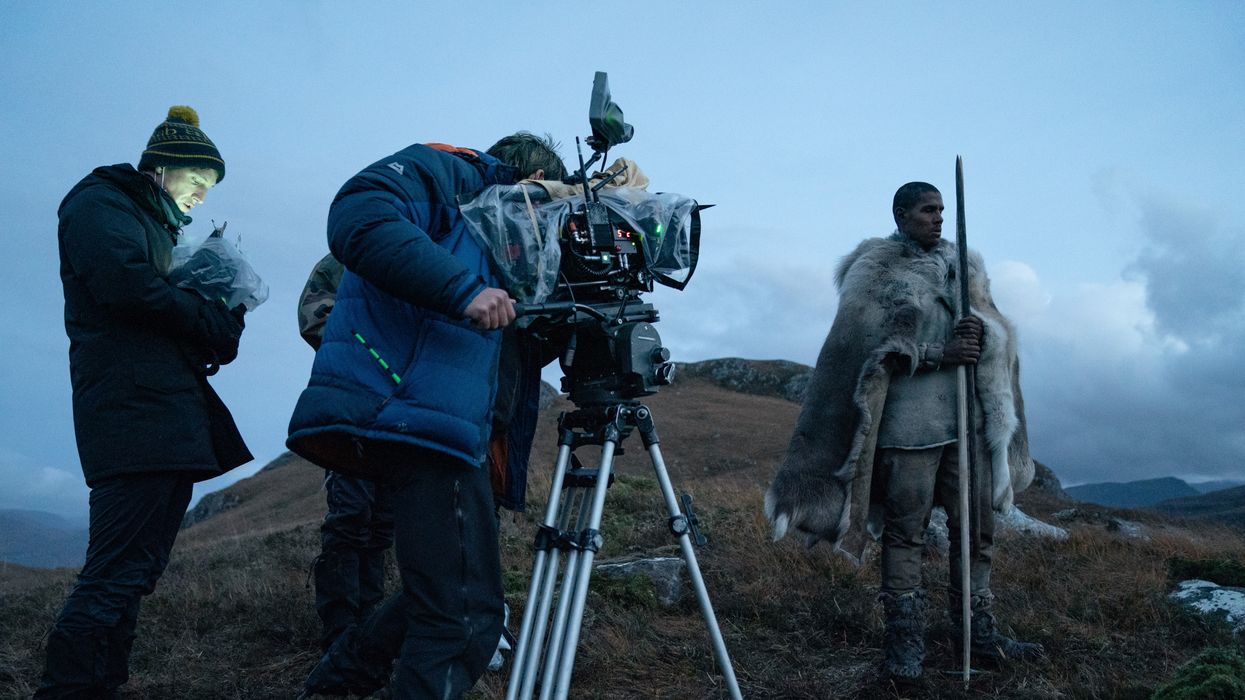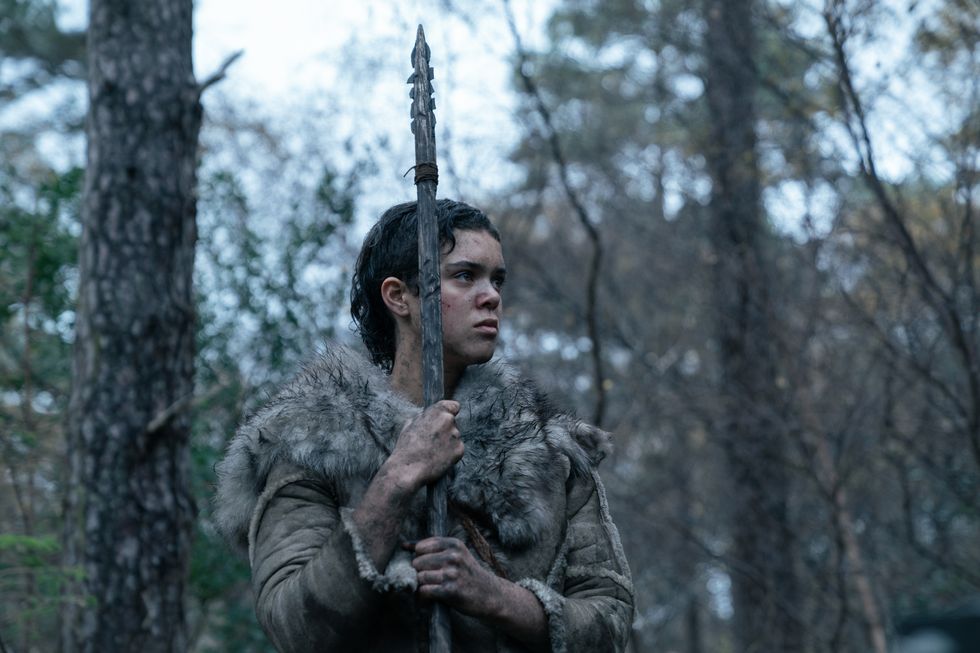The Secret to Sustaining Suspense With Minimal Lighting in 'Out of Darkness'
Director Andrew Cumming breaks down how he mastered gripping survival horror for Out of Darkness.

Chuku Modu, Ben Fordesman, and Andrew Cumming BTS of Out of Darkness
In the mood for a prehistoric genre thriller set 45,000 years ago but don't know where to find one? Fear not, for now we have a wonderfully crafted one in the wonderful gift that is Out of Darkness.
Out of Darkness stands out for a lot of reasons, but one of which is the very minimal, very effect story. Director Andrew Cumming doesn't shy away from brutality and fear, but when its executed he does so in a way to make it count. It's a wonderful bottle of a film with expertly executed suspense shamelessly inspired by Ridley Scott'sAlien.
No Film School was lucky enough to chat with Andrew, where he discusses building suspense with minimalism, predominantly using fire as a practical light source, and how to create an Aurora Borealis Sequence.
The following quotes are edited for clarity and readability
The Art of Minimalism to Build Suspense

Out of Darkness
Courtesy of Bleeker Street
"So with the monster, I kind of have to hold back [like in] Alien.
It's funny, I was just saying this before. I love Alien. It's one of my favorite movies of all time. Out of Darkness and Alien share a very common story structure, and we're very unashamed about that. That movie is so perfect.
The only time it slightly falls apart for me is when Yaffet Kotto and Veronica Cartwright are being held, and [it cuts to a] wide shot and we see the alien full length. It's [very clearly] a guy in a suit. It's fine because it's HR Geiger and looks phenomenal, but it is a guy in a suit, and it slightly takes you away from that mystery.
So it was all about how the tension comes from how long can we keep that mystery going about what this thing is where it is, how fast is it, how strong is it, how many are there?
Once you've committed to the the challenge of holding this thing back for as long as possible until you just can't anymore. Then that's partly in the cut. It's partly about, right, okay, we'll take frames out there. We'll slightly ramp the speed up on this part where [the monster] crosses, because you don't want people to get too much of a glimpse, and then it's that old truth about the things that you make up in your head are far more potent than the things you see.
And that's when you lean on a great sound designer like Paul Davies. He wanted to mix the film in Dolby Atmos, and that gives you so many tools in terms of where these sounds are coming from and how you spread the journey of this creature around the space, around the campfire.
So it's a much more subjective experience. Yeah, I mean, it's funny because at the time as well, we were shooting in Scotland and the schedule was really tight, and at the end of every day I didn't always have time to get POV shots. And then we got into the edit and turned to my producer and I was like, we really need some POV shots because we just didn't have them.
So we had some money left in the budget, and we went and did a few pickup days just to get a few things we needed, and a lot of them are POV shots, and it almost seems like such a cheat code, but I wasn't really aware of it until you see it on a screen of you can only have an actor's faces looking scared for so long before you need to experience what they do, and it's just something that you get lost in the fog of making the film.
So, yeah. POV shots, knowing when to slow down and when to speed up, and knowing when to just hold back on the threat, I think that all helps."
How Minimal Lighting Was Used to Shoot 'Out of Darkness'

Out of Darkness
Courtesy of Bleeker Street
"I loved what Ben Fordesman (Director of Photography) did on Saint Maud and the movie our movie shares a producer.
I met Ben, and we have a very similar idea of aesthetics and what constitutes believable and good cinematography, and yeah, the challenge was like you say, where is the light source? Because you can't cheat and have a character switch on their mobile phone or use car headlights or streetlights.
So it was mostly the fire, and we used a real fire and we were able to turn the flame up or turn the flame down to increase the brightness. Maybe a little bit of something from an LED panel on the other side, just to give the tiniest amount of, I don't want to say fill, but just something in the eye. So you're getting that detail and that emotion from the eyes. Our moonlight light was actually quite a low light that just raked across the trees in the forest, for example.
You get that lovely, that pattern of that linear, the trees acting like a prison, and the actors pass through these shadows and back into light."
This is How To Create an Aurora Borealis Sequence
"Then obviously the Aurora Borealis sequence, that was something at script stage that I pitched to Ruth and Oliver. I was just thinking of how do you inject more color and more expressionism at certain points that feel right [for the story].
So yeah, we picked the moment where things are really falling apart within this small group to create something that felt quite spiritual and threatening and strange and venomous, but also ethereal. I love that sequence because what Adam did with the music feels epic, but also feels very threatening.
That's the movie in a nutshell, basically: epic and threatening.
The wide shot was done in post, so the effects company tried to create originally, because most Aurora Borealis shots are sped up, and that's how you get the kind of quiver thing.
I said to them, 'Well, obviously I don't want to do that, because then it's like, well, how did you get a time-lapse camera on top of that hill 45,000 years ago?' It just felt fake.
Then they showed me what it would look like if it didn't have all that movement, and it just looked like a static image. So we kind of had to lean into what people's ideas of the Northern Lights are.
But in terms of how we pulled it off physically on the day, very simple.It was one key light, really high looking down, and I know, I think it was on a program, it wasn't a manual dimmer, but it was on a program to give it this random in and out quality of fading from black back up and then down again.
It was great because then you've got the characters moving through the space and you can reveal certain things when the light comes up, and then when it goes to black, I can get the actor out of the shot. It makes it feel a lot more, there's something supernatural and strange and mysterious about it, but again, it's very practical. It's just one light with a screen controlled from an iPad to get the right color of green, and then you just strobe it, really."
Andrew's Advice? Go Big and Stand Out

Out of Darkness
Courtesy of Bleeker Street
The only thing I would say in regards to Out of Darkness and giving advice would be don't be afraid to take a big swing, because there's so much—I don't like the word content. There are so many things getting made, and your eyeballs are just constantly being diverted here, there and everywhere to watch stuff and consume stuff at such a rapid rate.
Stand out if you've got a big idea, a big concept, because I didn't think I'd make this movie for 20 years. So to be given the permission by producers to say, 'Well, why can't this be your first film? Why can't you stand out from the crowd?'
That's a scary place to be because there's no roadmap. There aren't many prehistoric horror movies. I couldn't go and talk to a funder and say this, it'll be like this.
You just have to trust your gut and also be honest with what you would pay to see at the cinema. You're the first audience, and you need to feel confident that you're making something that you would actually want to take money out of your pocket and pay to go and see. And then, yeah, just swing.
Just swing baby."
Out Of Darkness is now in theaters
- 5 Cinematography Techniques for Lighting for Darkness ›
- DIY Solutions for Shooting Underwater and in Deep, Dark Caves ›
- How Horror Filmmakers Succeed (and Fail) at Using Darkness in Their Movies ›













